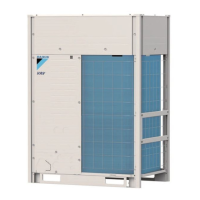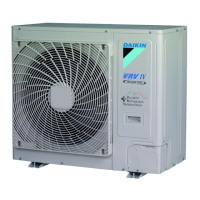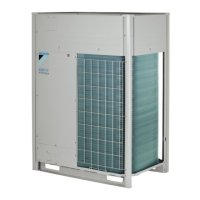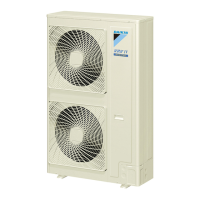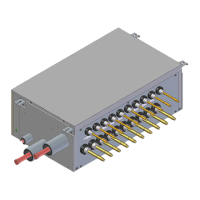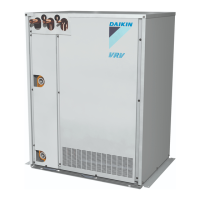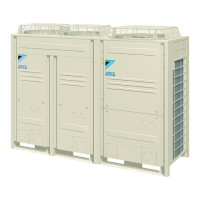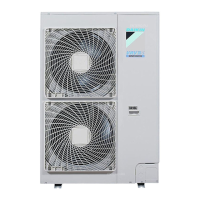5 Installation
Installation and operation manual
18
RXMLQ8 + RXYLQ10~14T7Y1B*
VRV IV system air conditioner
4P543426-1 – 2018.07
INFORMATION
If the total additional refrigerant amount was reached in
step 4 (by pre-charging only), record the amount of
refrigerant that was added on the additional refrigerant
charge label provided with the unit and attach it on the
back side of the front panel.
Perform the test procedure as described in
"7Commissioning"on page23.
Charging refrigerant
a Weighing scales
b Refrigerant R410A tank (siphon system)
c Vacuum pump
d Refrigerant charge port
A Valve A
INFORMATION
For a multi outdoor unit system, it is not required to
connect all charge ports to a refrigerant tank.
The refrigerant will be charged with ±22 kg in 1 hour time
at an outdoor temperature of 30°CDB or with ±6kg at an
outdoor temperature of 0°CDB.
If you need to speed up in case of a multiple outdoor
system, connect the refrigerant tanks to each outdoor unit.
NOTICE
▪ The refrigerant charging port is connected to the piping
inside the unit. The unit's internal piping is already
factory charged with refrigerant, so be careful when
connecting the charge hose.
▪ After adding the refrigerant, do not forget to close the
lid of the refrigerant charging port. The tightening
torque for the lid is 11.5 to 13.9N•m.
▪ In order to ensure uniform refrigerant distribution, it
may take the compressor ±10 minutes to start up after
the unit has started operation. This is not a malfunction.
5 Proceed with the manual charge.
INFORMATION
After charging refrigerant:
▪ Record the additional refrigerant amount on the
refrigerant label provided with the unit and attach it to
the backside of the front panel.
▪ Perform the test procedure described in
"7Commissioning"on page23.
5.6.6 Step 6: To manually charge refrigerant
INFORMATION
The manual refrigerant charge operation will automatically
stop within 30 minutes. If charging is not completed after
30 minutes, perform the additional refrigerant charging
operation again.
5.6.7 Checks after charging refrigerant
▪ Are all stop valves open?
▪ Is the amount of refrigerant, that has been added, recorded on the
refrigerant charge label?
NOTICE
Make sure to open all stop valves after (pre-) charging the
refrigerant.
Operating with the stop valves closed will damage the
compressor.
5.6.8 To fix the fluorinated greenhouse gases
label
1 Fill in the label as follows:
b
Contains fluorinated greenhouse gases
2
1
1
1
2
2
kg
tCO
2
eq
GWP × kg
1000
=
=
+
kg
=
kg
=
GWP: XXX
RXXX
a
f
c
d
e
a If a multilingual fluorinated greenhouse gases label is
delivered with the unit (see accessories), peel off the
applicable language and stick it on top of a.
b Factory refrigerant charge: see unit name plate
c Additional refrigerant amount charged
d Total refrigerant charge
e Greenhouse gas emissions of the total refrigerant charge
expressed as tonnes CO
2
equivalent
f GWP = Global warming potential
NOTICE
In Europe, the greenhouse gas emissions of the total
refrigerant charge in the system (expressed as tonnes CO
2
equivalent) is used to determine the maintenance intervals.
Follow the applicable legislation.
Formula to calculate the greenhouse gas emissions:
GWP value of the refrigerant × Total refrigerant charge [in
kg] / 1000
2 Fix the label on the inside of the outdoor unit near the gas and
liquid stop valves.
5.7 Connecting the electrical wiring
5.7.1 Field wiring: Overview
Field wiring consists of power supply (always including earth) and
indoor-outdoor communication (= transmission) wiring.
Example:
a
b
dd d
c
b g g
h h
c
fffh
eee
a
h h h
h h
i
a Field power supply (with earth leakage protector)
b Main switch
c Earth connection
d Outdoor unit
e Indoor unit
f User interface
g Indoor power supply wiring (sheathed cable) (230V)
h Transmission wiring (sheathed cable) (16V)
i Outdoor power supply wiring (sheathed cable)
Power supply 3N~50Hz
Power supply 1~50Hz
Earth wiring

